The Pirate´s house in Cadiz (Spain)
Friday, February 15, 2013
America and Cadiz are so inextricably linked to the ocean that separates them has become an inexhaustible source of legends. Stories of pirates, sailors, shipwrecked. Stories of love and indifference. From exotic treasures and riches brought from the distant, and so close, American lands. Legends that sink in the imagination as the ships sail the seas, creating wakes that enhance the story. But some of those stories are born of truth and reality. And the Legend of the Pirate's House is one of them.

The pirate´s house
The story goes that a young Marine Cadiz went to India in search of fortune, leaving his beautiful young wife waiting in the port of Cadiz. The story goes that she was up every morning to the lookout tower in the distance looking boat sails on her lover to return. But her lover did not return. And the tragic news came in one of the galleons from America: the young sailor Cadiz boat had sunk off the coast of the West Indies. But the wife denied the death of the sailor. His heart was alive and felt his presence every night. And every night praying for the return of her husband, cursing himself for having allowed him to swear that he would cover gold and let him go to fulfill his promise.
Many would, no doubt, those who mourned the death of the sailor and the folly of his young wife, unable to accept the death of her beloved husband. That every day and every night up until the tower waiting for the boat in which his beloved back. And so every day until the day he returned laden with gold and riches.
The sailor had arrived at an almost deserted island, where he soon established contact with pirates of all nationalities. And there, in that place, forsaken of God, he could make a fortune, so that now he came ready to fulfill his promise . And come back for more, for all that he had to leave to return to Cadiz.
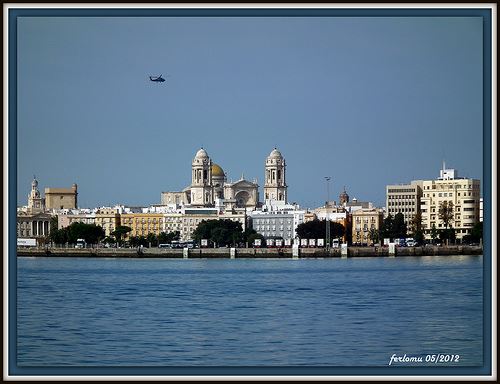
"Cadiz 18", Cadiz, South of Spain, by ferlomu, at flickr.com
When the sailor told his wife that he would return to the sea, she made him promise that he would stay in town, or die for the love away. And he accepted and fulfilled the promise. But he missed the sea and walked sad through the port. She then commanded to build a house as beautiful as her. A house that reminded her husband a boat, with large windows that looked like feathers of gulls who accompanied him on his lonely island. With a bridge from which you could navigate by turning an imaginary steering wheel.
And in the house the couple lived until her death uprooted happiness. The navy kept his promise, and his wife buried gold. Legend has it that two young rascals learned of the rich burial and, taking advantage of the darkness of the night, stole all the gold that covered the body of the beautiful woman. The husband, on learning what had happened, was furious. Chock his gun and killed the grave robbers.
Since then the Pirate´s House remains unperturbed recall of its first owners. And today, sunk into ruin, stone seems to mourn those much-loved within its walls.
Visit Cadiz and you will be abble to see this house.
Kind regards,
Luis.
Please click down here:
.jpg)
Y en aquella casa vivieron los dos esposos hasta que la muerte le arrancó de cuajo la felicidad. El marino cumplió su promesa, y el oro que cubría el cuerpo de la hermosa mujer.
El marido, al enterarse de lo ocurrido, montó en cólera. Calzó su arma y mató a los ladrones de tumbas.
Y en aquella casa vivieron los dos esposos hasta que la
 0
Like
Published at 1:24 AM Comments (0)
0
Like
Published at 1:24 AM Comments (0)
Another Spanish sayings and proverbs, 45
Wednesday, February 13, 2013
This is also a very used expression in Spain:
A posta = On purpose.
Or what amounts to the same: by the way, intentionally, with deliberation.Thus comes the voice adverbial post, which was but the retention of chivalry established at intervals along the way to make the relay necesarios.La variant "Going by the post", meanwhile, has come to mean, for metaphorical derivation , suffer extremely serious and earnest signs pass away.
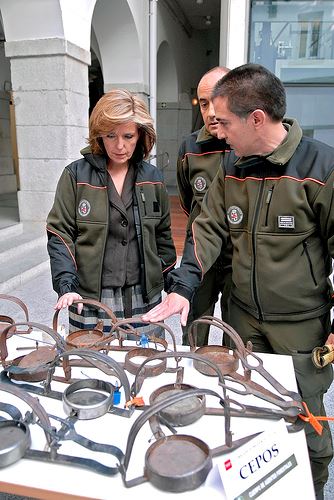
Los Agentes Forestales de Madrid incautan 420 trampas ilegales para capturar animales en 2011 (24 Enero 2012), Madrid, Spain, by Comunidad de Madrid, at flickr.com
These traps have been set on purpose.
Kind regards,
Luis.
Sponsored by Costaluz Lawyers.
Please click down here:
.jpg)
 0
Like
Published at 11:32 PM Comments (0)
0
Like
Published at 11:32 PM Comments (0)
Novelty in the purification of water in Spain
Tuesday, February 12, 2013
Researchers at the University of Granada experiment with bacteria to improve water reuse and want to try it in a real-purifier, like this:
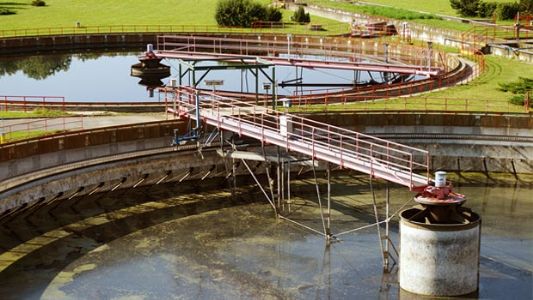
Purifier of sewage. Cortesy by Thinkstockphotos.
These researchers have configured low cost bioreactors debug and industrial wastewater. These containers in which takes place a chemical process involving bacteria, in this case, selected 'a la carte' to remove contaminants.
Scientists, from the Department of Microbiology and Civil Engineering, have demonstrated the development of specific microbial biofilms when modifying the technical characteristics of the support which they were developed, and have managed to optimize the treatment processes.
In a statement, the "Discover Foundation" explains that experts have found that bioreactors can be configured for each type of waste, just as microorganisms adapt to environmental conditions that define them.
"We tested microorganisms changes in reactor design function and when 'we force' to decontaminate nitrogen, for example, adapted to the medium. Thus one can achieve almost unlimited potential to degrade any compound, whether adjust environmental conditions", explained the researcher Jesús González.
To achieve this specialization of the bacteria, the researchers had to study the types of microorganisms in the reactor and how they respond to environmental changes for a given pollutant.
Specifically analyzed how respond to various compounds, for example a toxic product dissolved in water, raising what conditions should help to ensure that the microorganisms survive and to selectively degrade contaminants.
This knowledge allows the development of bioreactors 'a la carte', that is, low cost biological systems tailored to each pollutant. Another novelty of the research is the application of molecular techniques to the study of microbial populations.
So far the bioreactors were tested pilot plant scale, but researchers now intend to transfer the results to an actual treatment plant. Bioreactors working with the University of Granada are biological systems for the treatment of domestic and industrial effluent where bacteria convert waste into non-polluting compounds, thereby allowing water to be reused.
This one seems to be a very important advance.
Similar than this case of the wastewater treatment is the tretment of water from sea.I should like to see anyday how they get a lot of water, from sea, to treat that water and use it in Spain and to give a lot to poor countries.
Kind regards,
Luis.
Sponsored by Costaluz Lawyers.
Please click down here:
.jpg)
 0
Like
Published at 12:30 PM Comments (0)
0
Like
Published at 12:30 PM Comments (0)
Aracena: A Roman village in the south-west of Spain
Tuesday, February 12, 2013
This village is situated in the north of the provinve of Huelva and 104 kilometers from the capital, Huelva. It is also 89 kilometers from Sevilla and 700 meters over the sea. It is a white village; a flawless people, by the state of their homes and streets, where you can see low rise and whitewashed houses, built with an andalusian style and the bars are not lacking to adorn the facades. The pavements of limestone soil are found in almost all the village. It has grown a lot in the last years and that has transformed some points in the village, which has 6.600 inhabitants.
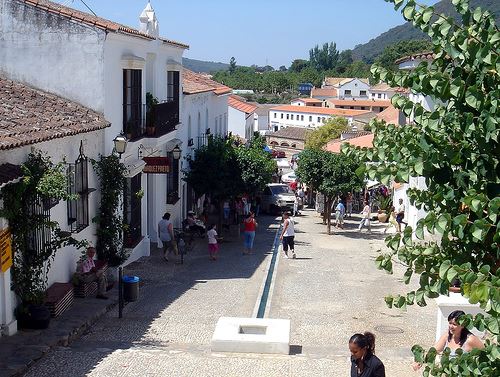
"Aracena", Huelva, South-west of Spain, by David Domingo, at flickr.com
Aracena is the tourist center of the northern mountains of Huelva, both its main attractions such as the Cave of Wonders and the castle church, for the many taverns, where you can enjoy good food and of course , the excellent ham serrano.Es also good place for shopping, mainly handicrafts and antiques.
There is no very accurate documentation of the origin of Aracena, but most sources agree that this is a roman settlement. Agreement with the formation of Aracena name, it would mean that it was the property of someone named Aretius or Arcius.
Aracena was for centuries a place of border disputes and altercations between different army.In the year 1251, the troops of Alfonso I of Portugal expelled the Arabs, recapturing the city to the Kingdom of Portugal.After some years of disputes between Spaniards and Portuguese, for dominance of the region by the Treaty of Badajoz, in 1267, it belongs to the kings from Castilla.Alfonso X ceded the city to the Knights Templar, whose jurisdiction was maintained until 1312.In 1640, it depends on the Earl Duke de Olvares and in the eighteenth century and early nineteenth century, the Earl of Altamira. The nineteenth century would bring new war events, due to the French invasion and the War of Independence.In one of the mountains nearby, called "Sing the rooster", took place one of the bloodiest battles in recent memory. Aracena city was declared officially, in 1901, by the regent Queen. In the last decade has been very important to the local economy the tourism phenomenon, although it remains in force the farming traditions.
Un paseo por el pueblo permite admirar algunas construcciones de arquitectura popular como las casas mudéjares de las calles Madre Trinidad and Francisco Rincón.
In the street Constitution, there is also a Renaissance house, from the century XVI.Also can be seen some buildings belonged to the named “School of Sevilla”, job of the Architect Anibal González, author of the “Square of Spain of Sevilla”. For example: the Casino Arias Montano, the Square of Abastos or the Town Hall.
Also you can visit:
The Canern of the Wonders.
Castle and Church of the Castle.
The old Council. In the past, it wa the Town Hall.
Church of the Assumption.
Convent of Saint Catalina.
Casino Arias Montano.
Church of El Carmen.
Musseum of ham.
Also you can do several excursions:
Fuenteheridos.
Cortegana.
Natural Park of the Mountains of Aracena and Peaks of Aroche.
Some choosed accommodations:
Sierra of Aracena: A Hotel with three stars. Street Gran Via, 21. Telephone number: 959 12 62 18.
Los Castaños: A Hotel with two stars. Avenue of Huelva, 5. Telephone number: 959 12 63 00.
La Casa Noble (The Nobel House): Street Campito, 35. Telephone number: 959 12 77 78.
Two rural accommodations:
Finca La Silladilla (Property The Silladilla). Road Los Romeros.Jabugo. Telephone number: 959 50 13 50.
Finca Valbono (Property Valbono). Road Aracena-Carboneras, Km 1. Telephone number: 959 12 77 11.
Well, I hope that you can come to Aracena very son.Enjoy it .
Kind regards,
Luis.
Sponsored by Costaluz Lawyers.
Please click down here:
.jpg)
 0
Like
Published at 1:07 AM Comments (0)
0
Like
Published at 1:07 AM Comments (0)
Alhama de Granada: A village with history in the south of Spain
Sunday, February 10, 2013
A small and picturesque village of its Arab heritage, alongside the River Tagus Bailon. The action of this river over the centuries has made the villa is immersed in a wild landscape of rocky cliffs pierced.
Alhama de Granada is a beautiful village with white houses and red roofs, next to a pit which is presented as an ideal place to stroll. Located in the Western Granada, 58 kilometers southwest of the provincial capital and has an estimated population of just over 6.000 inhabitants.
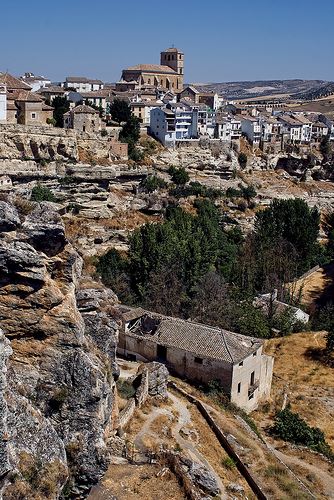
"alhama de granada, 1", Granada, South-east of Spain, by tim caynes, at flickr.com
The village is named, Alhama, cause of the hot baths and apparently, corresponds to the famous ballad of Alhama.
The poet of Loja, Ibn al-Khatib said Alhama: "It has abundant hunting and the wheat fields seem pieces of gold. It has hot springs, whose water heals the sick and they can use all kinds of people, rich and poor .... ".
The Christian conquest of Alhama was especially dramatic. While Caid was at a wedding celebration in Velez-Malaga, a day in 1482, the Marquis of Cadiz, in command of a squadron, attacked the city by surprise, in response to the raids of Granada against Zahara. The fight, almost every house, was bloody and once taken the square, Christians no longer lost, despite numerous attempts to reconquer nazaries.
From Alhama, which became important military base, Christians undertook numerous expeditions against the last strongholds of Alandalus.
Perhaps the most striking are its wonderful Arab Bath --built upon a century Romans from the Century One--, built attractively horseshoe arches of the twelfth century, located just outside the village, in the spa, 2 kilometers of Alhama, where, in fact, is made up the waiting room. At the gates of the Spa can take a free hot water bath, because the flow is not used in the hotel, wander to the river. At the gates of the Spa can take a free hot water bath, because the flow is not used in the hotel, is diverted to the rio.Los baths can be visited every day from 14-16 hours.De road to wellness after taking the deviation from the general, we must look at the Roman Bridge, in the first century, before Christ.
Once in town, almost all the monuments are in the lower old town.
In Alhama, you can visit several churches:
Parish or Mayor Church of Santa Maria de la Encarnacion.
Conventual Church of Carmen.
Church of Remedies.
As a choosed lodgings, you have The Health Resort of Alhama de Granada. Telephone number: 958 35 00 11. (balnearioalhamadegranada.com).It is 3 kilometers , through the road of Granada; it is a buiding situated in a magnificent and picturesque landscape, greenery oasis between the dryness of the surrounding landscape.
The spa waters are especially recommended for rheumatic diseases and respiratory tract and the hotel offers a variety of spa treatments and spa.It has 116 rooms from 90 Euros, and 170 with full board. En board facilities are the old Arab baths.
As a rural accommodation, you can go to “La Seguiriya”, in the street Las Peñas, 12. Telephone number: 958 36 08 01.In the rural house, they prepare a excellent regional cuisine., with Menu around 18 Euros. If you want to eat another food, you will pay around 24 Euros.They have some very good desserts.
I hope that you can visit Alhama, so soon.Then, I hope you enjoy it.
Kind regards,
Luis.
Sponsored by Costaluz lawyers.
Please click down here:
.jpg)
 0
Like
Published at 1:19 AM Comments (1)
0
Like
Published at 1:19 AM Comments (1)
Another Spanish sayings and proverbs, 44
Friday, February 8, 2013
This is a very used expression in Spain:
A pie juntillas = Blindly
Though its structure is not consistent, with this popular adverb --that seems to be a child denomination of the act of jumping with feet together-- we understand firmness and unwavering assertion. Therefore it is normally associated to the verb To Believe. For example: "You will have all the questions you want, but I believe in him blindly, because I know him".
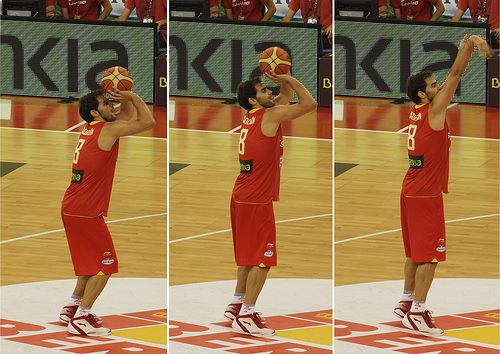
"España - Eslovenia (Tiro libre de Calderón)", Granada, South-east of Spain, by TonioMora, at flickr.com
Kind regards,
Luis.
Sponsored by Costaluz Lawyers.
Please click down here:
.jpg)
 0
Like
Published at 12:33 PM Comments (0)
0
Like
Published at 12:33 PM Comments (0)
Analyzing paintings from Spain
Thursday, February 7, 2013
Knowing what works of art hidden in painting and see their secrets through augmented reality will be easier in the medium term future. The company based in Asturias, Treelogic, leads an European project known as “Insidde” to develop a system that will display the sketches and other images hidden under the canvas.
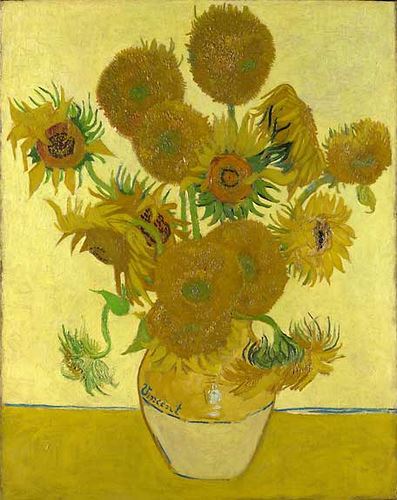
"Van Gogh", by tonynetone, at flickr.com
Specifically designed to create a new type of scanner that uses transmitters and receivers terahertz band, a frequency that does not damage the works. The sending and receiving of the signal will be of graphene, a material first synthesized in 2004. The prototype that is generated will simplify, move more easily and more affordable scanners artworks.
The scanner will reveal the secrets that are under the canvas, other media of painting, pottery and other content of closed three-dimensional objects. The project, which will be held in three years, aims to develop graphene scanner during the first year.
In this phase the technology center Asturian Materials Technology (ITMA) will provide modified graphene bands to act as receptors and issuers terahertz frequencies. For its part, the University of Oviedo, through its area Signal Theory,will integrate these innovative materials in devices that form the scanner.
As indicated by the members in the presentation of the project, the terahertz band lies above those using mobile or satellite communications. "Begin to use is to cover a niche between the frequencies used by other existing technologies," said Treelogic researcher and coordinator of the initiative, Javier Gutierrez Meana.
In the next phase, the Delft University of Technology (Netherlands) and the Belgian company put in place “3DDynamics” image processing to generate, respectively, two-dimensional models for paintings, frescoes and the like and three-dimensional models for vessels and other objects with volume.
While end users of the technology developed as museums, Treelogic disseminate results through an augmented reality technology and made available to all Internet models generated through *Europeana network.*Click on Europeana.
The project has a total budget of 3.64 million euros (of which almost 2.9 will be provided by the EU) The head of R & D Treelogic, Sergio Garcia Caso, has estimated the economic return for the economy Asturias could amount to more than 1.3 million euros.
Treelogic addition, Insidde up the European project, the ITMA Materials Technology and the University of Oviedo. They join five other European partners: the Delft University of Technology (Netherlands), the Doerner Institut (Germany), the Istituto Nazionale di Ottica (Italy), the Regional Museum of History of Stara Zagora (Bulgaria) and the Belgian company 3DDynamics .
The project also involved the INCAR-CSIC, through the incorporation of the doctors Rosa M. Menéndez and Patricia Álvarez Rodríguez, to the Committee of Experts to advise the consortium.
I think that it is a very interesting theme.And I hope tha the results of the project are good.
Kind regards,
Luis.
Sponsored by Costaluz Lawyers.
Please click down here:
.jpg)
 0
Like
Published at 12:29 PM Comments (0)
0
Like
Published at 12:29 PM Comments (0)
A spanish video: The Best Scientific Video of the Year
Wednesday, February 6, 2013
The Display Equipment of the Barcelona Supercomputing Center (BSC-CNS) has just got the recognition of “The Best video of the Year”, because they have created a simulation of the human heart.
Here you can watch the Video.Please click down here, on the link and, after, on the window up and right of the website:
http://www.xatakaciencia.com/salud/video-mejor-video-cientifico-del-ano-una-simulacion-del-corazon-realizado-en-espana
The Award, given by the National Science Foundation (NSF) and the magazine “Science”, to the video named “Alya Red: a computational heart”, consists in the presentation of this project and another ones, published in that magazine, February.
This video has competed between 200 projects, from 18 countries.Members of the magazine and of the NSF selected the most outstanding and they published the result in a website.Then, people could vote to those projects.There were more than 3.150 votes.The Alya Red got the both awards: from the jury and from the popular vote. The BSC-CNS has a team of scientific visualization, in close collaboration with researchers; this team develops videos and images that help to interpret the data so as to release.
The team is composed of a heterogeneous mix of scientists, engineers and graphic designers trying to get numerical data representations to highlight science correctly and, at the same time visually appealing. "Alya Red: a computational heart" describes research conducted by scientists from the center of Barcelona and his collaborators, emphasizing the complexity of the problem and describing the modern techniques used to attack him. As highlighted supercomputing center, the arc of the video goes through the motivation, the means and goals of the project and the underlying theme is the ancient heart of the problem and the use of supercomputers to try to understand.
The winner audiovisual shows, through the mixture of ancient medical imaging and 3D representations, the computer simulations. "Alya Network, a project of Biomechanics", takes its name from Alya System, the simulation tool made entirely in the BSC-CNS. It aims to develop a computer model to simulate the functioning of the human heart and is being developed by a multidisciplinary team involving physicians, bioengineers and researchers in medical imaging and supercomputing.
Today, thanks to Alya Red, scientists involved in the project can simulate ventricular models from real geometries. Another objective is to create a new tool to help better understand the functioning of the cardiovascular system to medical and pharmaceutical clinical research. This tool will be a simulation technology infrastructure related to high performance computing (HPC, by the acronym for High Performance Computing).
I want to send my congratulations to this team from the Barcelona Supercomputing Center.
Best regards,
Luis.
Sponsored by Costaluz Lawyers.
Please click down here:
.jpg)
 0
Like
Published at 1:20 PM Comments (0)
0
Like
Published at 1:20 PM Comments (0)
More funny phrases by spanish children 3
Tuesday, February 5, 2013
Marta, 4 años:
Marta oyó a su hermano mayor que el Hombre venía del mono.Así que, Marta le preguntó a su madre: "Mamá, ¿Cuando tú eras mono ya llevabas gafas?".
Marta, 4 years old:
Marta listened to her older brother that people come from monkey.So, Marta asked her mother: "Mam, When you were monkey do you use glasses?".
Nacho, 6 años:
Una mañana, cuando la madre de Nacho lo levantó, para ir al cole, él le dijo: "No quiero ir mas al cole.¡Bórrame!".Su madre le contestó: "Pero si ya no puedo borrarte.Tienes que ir al cole todos los dias".Nacho la miró asombrado y le dijo: "¿Es que me habeis apuntado con boli?".
Nacho, 6 years:
A morning, when Nacho's mother woke him up for school, he told her: "I do not want to go to school more, Erase me!".Her mother answered him: "But...I can not erase you.You have to go to school every day".Nacho looked at her amazed and he told her: "Have you signed me up with pen....?".
Manuel, 3 años:
En la escuela infantil, que va Manuel todos los dias, tambien hay bebés.Un dia, Manuel estaba mirando a un bebé de 10 meses, que estaba pasando las paginas de un cuento, mientras balbuceaba.Entonces, Manuel le dijo a la profesora:"No me gusta cómo lee en Inglés".
Manuel, 3 years:
In the infant school, where Manuel goes, everyday, there are also some babies.A day, Manuel was looking at a baby, 10 months old, how he was turning the pages of a story, while this baby was talking (babbleing).Then, Manuel told his teacher: "I do not like how he reads English!".
Isaac, 4 años:
Un dia, Isaac iba corriendo y tropezó con su hermana.Entonces, su madre le preguntó: "¿Qué tienes que decirle a tu hermana?" y él respondió: "Que se aparte....".
Isaac, 4 years:
A day, Isaac was running and he bumped into her.Then, his mother told him: "What do you have to tell your sister?" and he answered his mother: "That she moves to one side...".
David, 5 años:
Él les preguntó a sus padres: "Y cuando yo tenga novia, ¿Dónde vais a vivir vosotros?".
David, 5 years:
He asked his parents: "And when I have a girl-friend, Where will you live?".
Pedro, 4 años:
Hace un par de meses, los padres de Pedro decidieron hacerle el Carnet de Identidad,que llegó hace un par de semanas.Cuando la madre de Pedro se lo enseñó, él exclamó: "¡Ay, qué bien, ya puedo conducir!".
Pedro, 4 years:
Two months ago, Pedro´s parents decided to give him the Identify Card, that arrived home two weeks ago.When Pedro´s mother showed it to him, he exclaim:"Ay, thoughtful, already I can drive!".
Best regards,
Luis.
Sponsored by Costaluz Lawyers.
Please click down here:
.jpg)
 0
Like
Published at 12:18 PM Comments (0)
0
Like
Published at 12:18 PM Comments (0)
The World Cancer Day in Spain
Monday, February 4, 2013
Today is celebrated the “World Cancer Day” and I want to tell you about the recent advances against the colon cancer.
The Doctor Javier Rodríguez belongs to the Department of Medical Oncology, in the University of Navarra (North-east of Spain).He talks about colon cancer in a video that I want to show you.Please click down here (on the video in the website) and after I will translate his words for you:
http://www.abc.es/videos-abcsalud/20121113/ultimos-avances-contra-cancer-1964578961001.html
"Thanks to advances in molecular biology and genetic knowledge of colorectal cancer, the disease has undergone a major transformation in recent years, mostly aimed at trying to individualize treatment for each development patient. There are several lines that seem very promising, which could be summarized as follows: the first is the interaction between the pharmacokinetics and genomical. We know that drugs act at different levels and achieve an optimal dose for each patient, has shown much improved chance of improvement and survival of them. The genetic analysis at our disposal allow individualized dose for each person, so as to achieve greater efficiency with lower profile toxicity. There are several studies that support this type of strategy, with which is able to optimize the results of drugs so far available.
The second line of development would go through the discovery of "therapeutic targets." This has allowed us to find points that are important for the development of cells that are lockable, pharmacologically, which has greatly expanded the range of drugs available to us , so that not only are chemotherapy drugs, but increasingly more importance is given to the development of so-called "biologic drugs"., which have several advantages: its tolerance is very good; the side effect profile is very mostly small, which enhance the effectiveness of some chemotherapy drugs.
Furthermore, as a novel strategy is known today, that colorectal cancer is a tumor immunegenic. In the recent years begins to raise ways to stimulate the immune system to fight it's own tumor. There are preliminary data, very promising, regarding strategies that stimulate the immune system and result in an increased likelihood of improvement and in a longer time, in the control of disease.
In our Hospital, we have two studies , raised in vaccines, along with chemotherapy, with the idea that interaction between conventional drugs and immune system activation translate into better results in the medium and long term.
And finally, today generally arises continuing care strategy for patients with metastatic colon cancer, enabling both quality of life and survival are as long as possible".
I want to send a message of hope to all the patients.
Kind regards,
Luis.
Sponsored by Costaluz Lawyers.
Please click down here:
.jpg)
 0
Like
Published at 12:42 PM Comments (0)
0
Like
Published at 12:42 PM Comments (0)
The Candelaria in Spain
Saturday, February 2, 2013
Today is “The Day of The Candelaria”, because it is celebrated the Day of the Virgin “The Candelaria”, who is Patron of Tenerife (Canarian Islands, South of Spain).

"Geröll am Strand / boulder on the beach", La Candelaria, Tenerife, South-west of Spain, by bjoern .f / Bjoörn Freiberg Fotografie, at flickr.com
The origin of the name “Candelaria” is not sure, because for Christians, it is a Feast in honor of the Virgin La Candelaria, who appeared in Tenerife (South-west of Spain) In the early fifteenth century.It is in February – 2 and it spends several days, because it use to be the Patron of any village.
At the beginning, the Feast of the Candelaria or of the Light was originated in the Middle, where it had the name: “Encuentro” (Meeting).
After that, it was extended to West, in the Sixth century and it was held in Rome in penitential character.
For other researchers, it had its origin in the old Rome, where the Procession of the candles was a part of the Feast of the Lupercales.This celebration was united to the Presentation of the child Jesus in the Temple of Jerusalem, associated to altar candles, torch and candles and the Purification of the Virgin Mary after childbirth.
The feast is known and celebrated with several names: The Presentation of the Lord, The Purification of Mary, the Feast of the Light and the Feast of the Candles.All these names express the meaning of the Feast: Christ, the light of the World, introduced by his mother in the Temple, come to illuminate to everybody, as candles, from where it comes the name “Candelaria”.
After the appearance of the Virgin in Tenerife, the Feast of the Candelaria is celebrated with special Marian, since 1497, when the Conqueror of Tenerife, Alonso Fernandez de Lugo, celebrated the first Feast of the Candles (with the Virgin Mary of the Candelaria), coinciding with the Feast of the Purification, in February-2.
Later, this Feast was carry on to several countries in America.
Outside this religious character, it is thought that this Feast celebrates the beginning of the second part of the Winter, where the days become longer –so, we see more light--.
I hope that you ejoy this special Day, in Spain or out of here.
Kind regards,
Luis.
Sponsored by Costaluz Lawyers
Please click down here:
.jpg)
 0
Like
Published at 12:30 PM Comments (0)
0
Like
Published at 12:30 PM Comments (0)
Spam post or Abuse? Please let us know
|
|